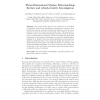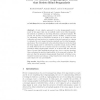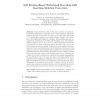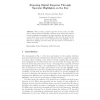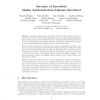IH
2007
Springer
15 years 5 months ago
2007
Springer
The recent decade has seen the emergence of 3D meshes in industrial, medical and entertainment applications. Therefore, their intellectual property protection problem has attracted...
121
click to vote
IH
2007
Springer
15 years 5 months ago
2007
Springer
Abstract. A new, simple, approach for active steganography is proposed in this paper that can successfully resist recent blind steganalysis methods, in addition to surviving distor...
160
click to vote
IH
2007
Springer
15 years 5 months ago
2007
Springer
Abstract. Hard decisions constitute the major problem in digital watermarking applications, especially when content adaptive embedding methods are used. Soft-decision decoding, on ...
IH
2007
Springer
15 years 5 months ago
2007
Springer
Abstract. When creating a digital composite of two people, it is difficult to exactly match the lighting conditions under which each individual was originally photographed. In many...
IH
2007
Springer
15 years 5 months ago
2007
Springer
Abstract. We introduce software integrity checking expressions (SoftICEs), which are program predicates that can be used in software tamper detection. We present two candidates, pr...
IH
2007
Springer
15 years 5 months ago
2007
Springer
d Abstract]∗
IH
2007
Springer
15 years 5 months ago
2007
Springer
Abstract. Dittmann, Katzenbeisser, Schallhart and Veith (IACR ePrint 2004) introduced the notion of invertible media authentication schemes, embedding authentication data in media ...
IH
2007
Springer
15 years 5 months ago
2007
Springer
We present a probabilistic program-transformation algorithm to render a given program tamper-resistant. In addition, we suggest a model to estimate the required effort for an atta...
IH
2007
Springer
15 years 5 months ago
2007
Springer
In this paper, we describe a new forensic tool for revealing digitally altered images by detecting the presence of photo-response non-uniformity noise (PRNU) in small regions. This...
IH
2007
Springer
15 years 5 months ago
2007
Springer
Abstract. This paper presents a security analysis for data hiding methods based on nested lattice codes, extending the analysis provided by previous works. The security is quanti�...
